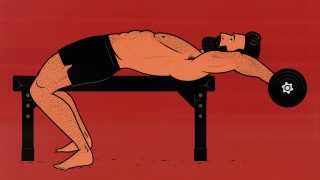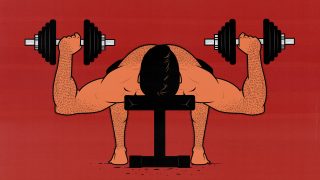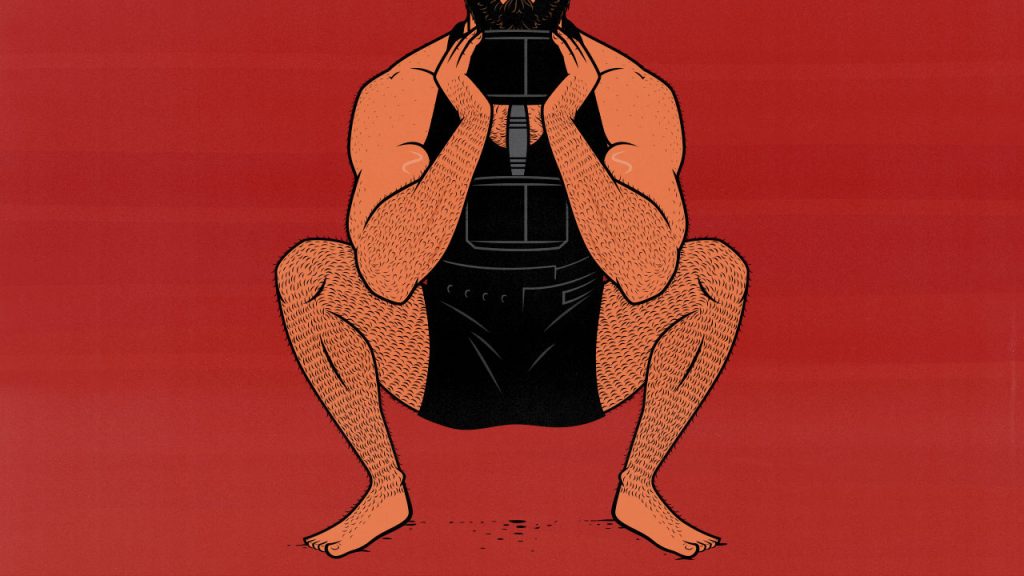
The Best Dumbbell Leg Exercises & Workout
Dumbbell leg exercises are great for beginners. They’re perfect for gaining your first 30–40 pounds of muscle. Think of exercises like goblet squats, dumbbell Romanian deadlifts, and step-ups.
Our main Bony to Beastly Program heavily emphasizes dumbbells. Some of our best transformations come from guys working out at home in simple dumbbell home gyms.
It gets a bit trickier as you get stronger. Dumbbells make it harder to lift as heavy. That isn’t as much of a problem for your arms, chest, or even back, but it can definitely make it harder to train your legs. You’ll need to progress to exercise variations that let you get more muscle growth out of less weight. We’ll show you how to do that.
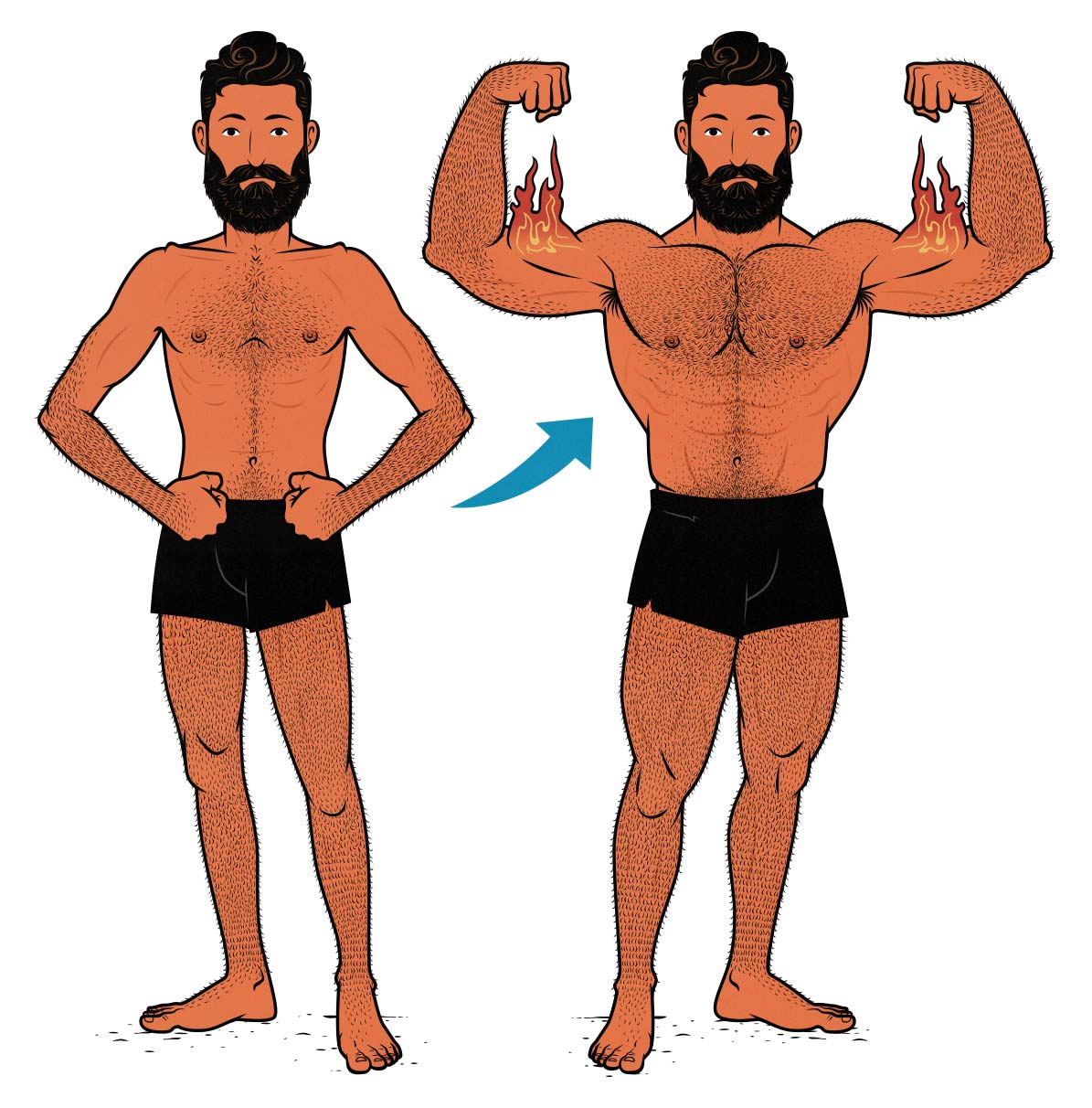
How to Train Your Legs
Leg exercises are difficult to do but simple to understand. Your quads open your knees. Your glutes, adductors, and hamstrings open your hips. That gives you two main movements to focus on:
- Squats: goblet squats, offset goblet squats, racked dumbbell squats, split squats, and Bulgarian split squats.
- Hip Hinges: dumbbell sumo deadlifts, dumbbell Romanian deadlifts, kickstand Romanian deadlifts, step-ups, and lunges. You could include hip thrusts here, but we rarely do.

You can supplement those bigger exercises with smaller ones. You can include some side planks for your smaller glute muscles, leg raises for your lower abs and hip flexors, and calf raises for your calves.
Each of these exercises has its pros and cons. Let’s go through one by one. Then, we’ll assemble them into a simple dumbbell leg workout.
The Best Dumbbell Quad Exercises
Dumbbell exercises are amazing for your quads. I’d argue that the goblet squat is by far the best beginner squat variation, even when people have access to a full gym. It lets you sink deep, works your quads hardest at the bottom, and encourages athletic lifting technique. If your dumbbells are heavy enough, you can get a lifetime of growth out of these.
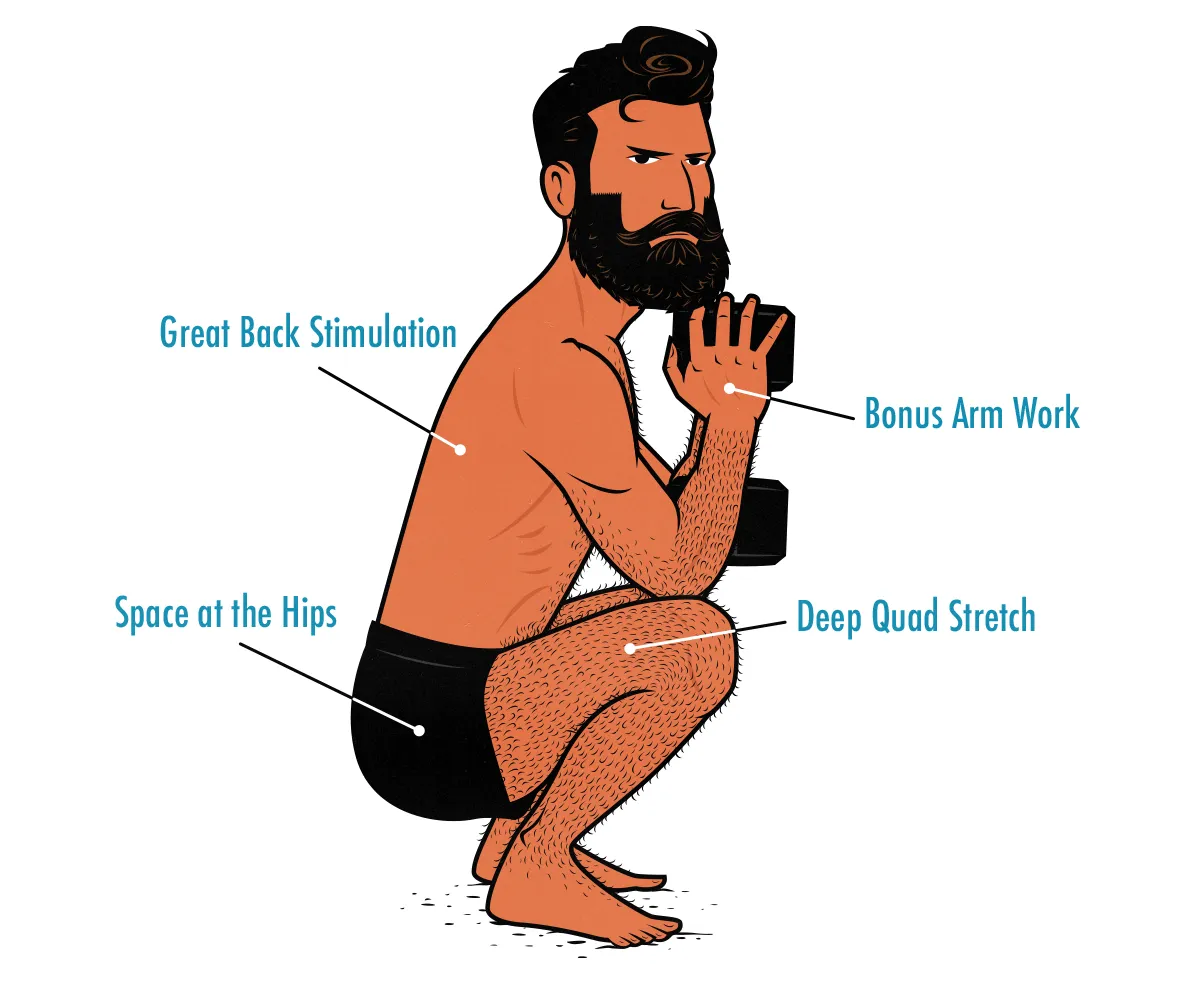
Squats are the hardest movement pattern to learn. Goblet squats make it easier, but it still takes practice. Here’s a tutorial video of Marco teaching the exercise. It’s a simple video that’s great for beginners, but this is also how he teaches professional and Olympic athletes. The best way to learn how to lift is to get a couple of simple cues, watch someone do the lift, and then try to imitate it.
Note that Marco is 6’4 with enormously long legs. He needs to hold the dumbbell fairly far in front of his body to keep his balance. Most people can hold the dumbbell right up against their chests.
You’ll need to choose your own stance width, too. A good trick is to pretend you’re about to jump. That almost always puts people into an athletic stance that’s great to squat from. From there, you can slightly adjust your foot positioning, depending on how your squats feel.
When you grow too strong for goblet squats, you can grab a second dumbbell and/or train one leg at a time. That isn’t quite as simple, but it works just as well. Here are my two favourite progressions:
- Double-dumbbell front squats are a heavier variation of goblet squats (tutorial video). When you grow too strong for a single dumbbell, you can grab two, resting them above your shoulders.
- (Bulgarian) split squats allow you to train one leg at a time (tutorial video). That can help you get more out of lighter dumbbells.
The Best Dumbbell Glute & Hip Exercises
The best way to stimulate muscle growth in your glutes, hips, and hamstrings is to challenge those muscles under a deep stretch. That means you should choose exercises that let you go deep and that are hardest in that bottom position (full explanation). That means deadlifts, not hip thrusts.
Dumbbell stiff-legged “Romanian” deadlifts are the best variation for your hamstrings. These make for a great default, at least until you grow too strong for them. Your hamstrings cross the knee joint, so they get much better stimulation when you keep your legs relatively straight, training them under a deeper stretch.
The downside to dumbbell Romanian deadlifts is that the dumbbells can be quite hard to hold onto. They’ll try to roll out of your hands. You can solve that by using lifting straps, or you can use your dumbbell Romanian deadlifts as a grip exercise until your grip grows strong enough. You can speed up that process by finishing your workouts with dumbbell farmer carries. (More on those in a moment.)
Here are some other variations you can use in your workout routine. I find step-ups pair great with dumbbell Romanian deadlifts.
- Kickstand Romanian deadlifts are a more challenging progression of Romanian deadlifts. You do your Romanian deadlifts with one leg at a time, using the other leg for balance. This can help you get more out of lighter dumbbells.
- Dumbbell good mornings are similar to Romanian deadlifts. The difference is that you hold the dumbbell in front of your chest. This works your spinal erectors a bit harder, but it’s also harder to load as heavy.
- Step-ups are great for your hips and quads (tutorial video). And since you’re only training one leg at a time, a pair of decently heavy dumbbells can remain challenging for quite some time.
- Dumbbell hip thrusts are a good finisher exercise for your glutes. When you grow too strong for them, you can do them one leg at a time.
Core Exercises
It’s pretty common to train your abs and core muscles along with your leg muscles. You don’t have to do it that way, but it can work quite well. It all fits together well.
Side planks are good for your obliques, gluteus minimus, and gluteus medius. They’ll help you build balanced hips and a stable core. You can make them harder by lifting your top leg. You can also rest a dumbbell on top of your hips.
Reverse crunches are good for your hip flexors and abs. They’ll give you a bigger six-pack and better ab definition (if you’re lean enough to see your abs). Many people find it helps improve their hip posture, too, though it’s hard to say for sure.
I like to do my core exercises between my sets of squats and deadlifts (as supersets). It’s a good way to keep your workouts shorter and denser. Your spinal erectors can be a limiting factor on deadlifts, but your abs and obliques won’t be. The exercises won’t interfere with each other.
Farmer Carries
Loaded carries are one of the oldest muscle-building exercises in history. Thousands of years ago, Milo of Croton carried a young calf, growing gradually stronger as the calf grew gradually bigger. It’s a great example of progressive overload.
The modern equivalent is an exercise called the dumbbell farmer carry, where you grab two heavy dumbbells and carry them for as long as you can. If you’re training at home, you can walk in circles or march in place. They’re great for strengthening your grip, traps, spinal erectors, and postural muscles.
The reason we recommend farmer carries along with your leg exercises is because they pair so well with dumbbell Romanian deadlifts. Both exercises will help you develop your grip and postural strength, supporting one another.
The Dumbbell Leg Workout
If you’re a beginner, I recommend following a 3-day full-body workout routine, including 1–2 leg exercises near the beginning of each workout and a core exercise at the end. That could be as simple as doing 3 sets of goblet squats, 3 sets of dumbbell Romanian deadlifts, and 3 sets of farmer carries.
When full-body workouts become too arduous, you can split your workouts up into different body parts, following a 4-day, 5-day, or even 6-day workout split. If you’re following an Upper/Lower split, you’d train your legs on Lower Body Day. On a Push/Pull/Legs Split or Bro Split, you’d train your legs on Leg Day.
| EXERCISE | SETS | REPS |
|---|---|---|
| Goblet Squats | 3–5 sets | 6–12 reps |
| Dumbbell Romanian Deadlifts | 3 sets | 8–20 reps |
| Step-Ups or Split Squats | 3 sets | 10–15 reps |
| Farmer Carries | 3 sets | 60 Steps |
| Side Planks | 3 sets | 10-15 reps |
You don’t need to do these exact exercises. That’s why we broke down all the best exercises above. But I thought it might help to have an example of what a good dumbbell leg workout looks like.
As mentioned above, I like to do the side planks between my sets of squats or deadlifts. You can trim a few minutes off your workout that way, and there’s no disadvantage to it.
This particular workout is designed for beginners and early intermediates. As you grow stronger, you’ll need to customize it to suit your particular situation. I’m not sure how heavy your dumbbells are, but when you grow too strong for them, you’ll need to progress the exercises.
Conclusion
I recommend training your legs 2–3 per week, training them quite hard, and getting almost enough rest between sets. That might mean doing these workouts every Monday and Friday, stopping 1–3 reps shy of failure and resting 2–3 minutes between each set. You can use shorter rest times for the smaller exercises.
As always, remember that the goal of lifting weights is to grow stronger over time. Every time you repeat a workout, try to lift more weight or get more reps than last time. If you can do that, you’ll gradually gain muscle and strength. If you aren’t getting stronger, you’ll need to find the source of the issue. I’m happy to help in the comments.
You’re free to modify the routine as you see fit. If you want to learn more about how to program workouts for muscle growth, we have a full article on hypertrophy training.
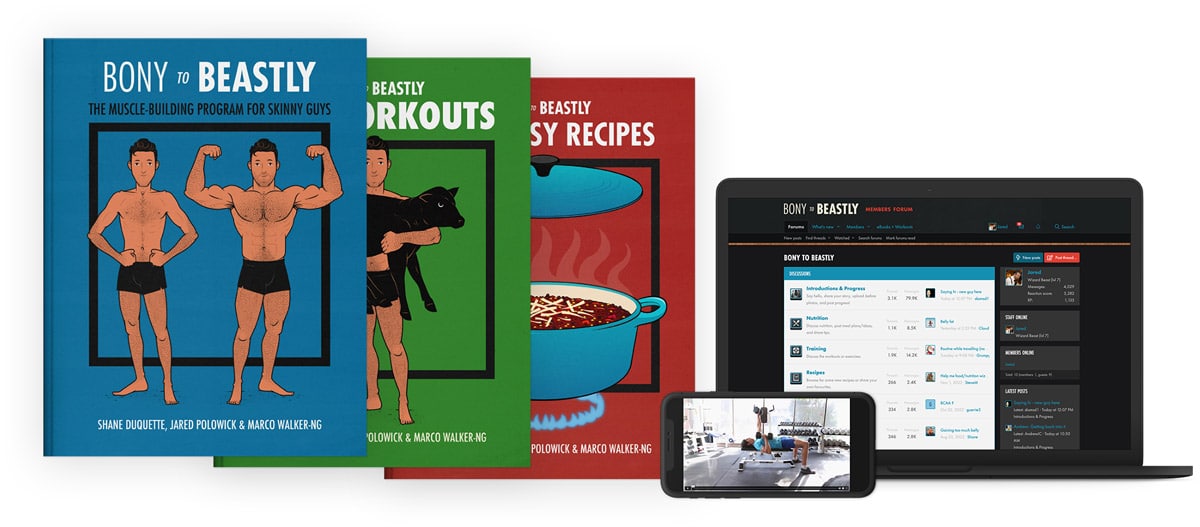
If you want us to walk you through the entire process of building muscle, check out our Bony to Beastly Program. It includes a 5-month dumbbell workout routine, diet guide, recipe book, tutorial videos for every exercise, and one-on-one support from us in our online community.
Alright, that’s it for now. If you want more muscle-building information, we have a muscle-building newsletter.




